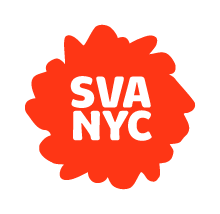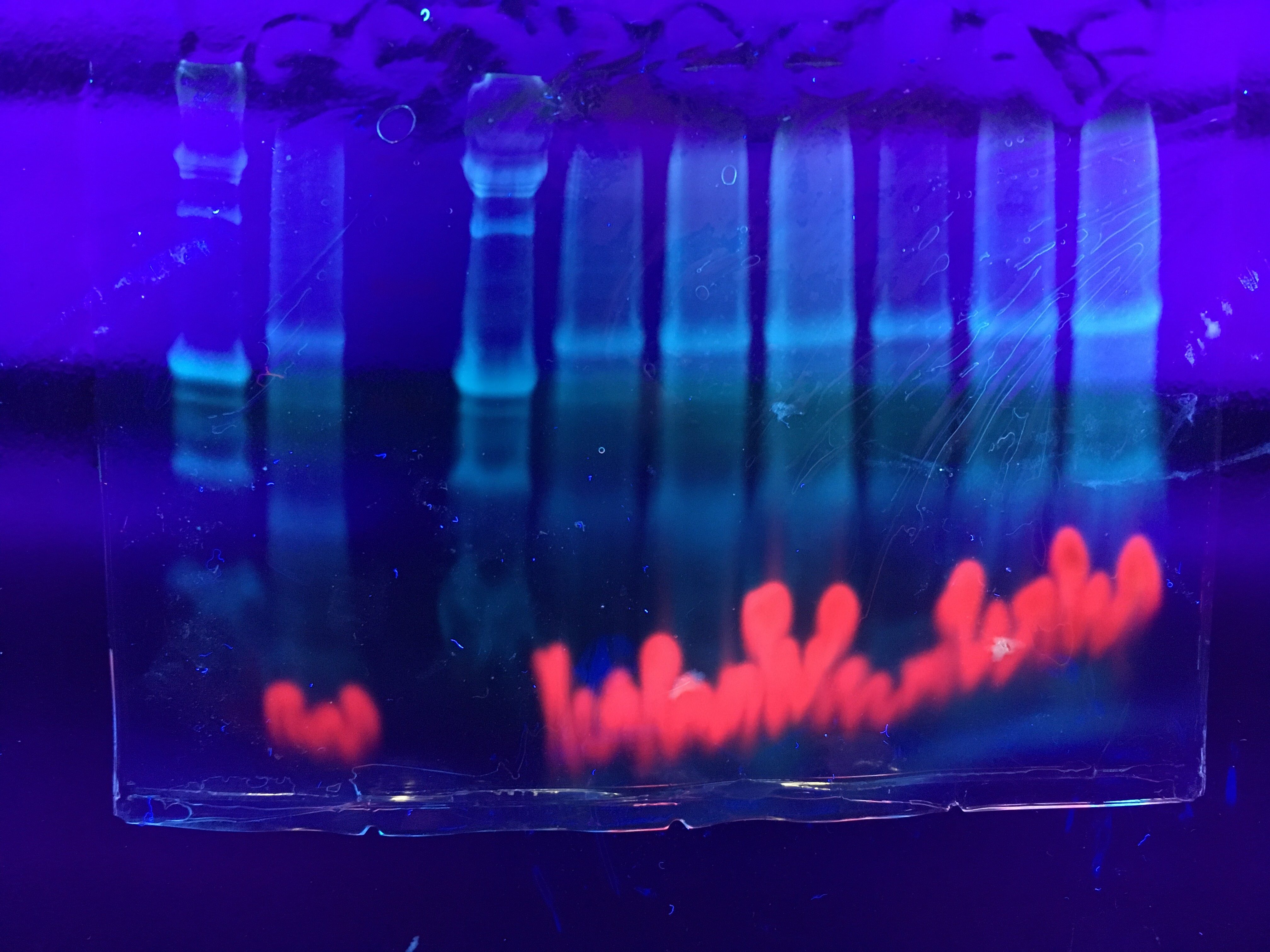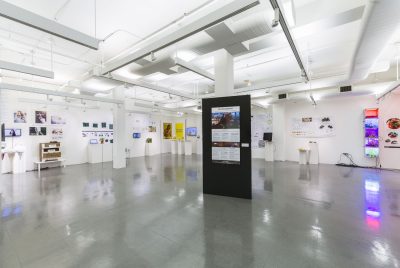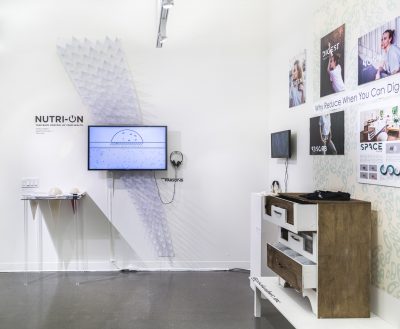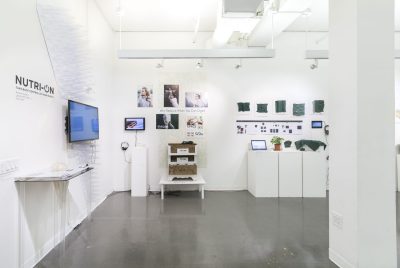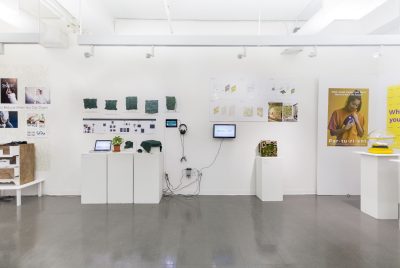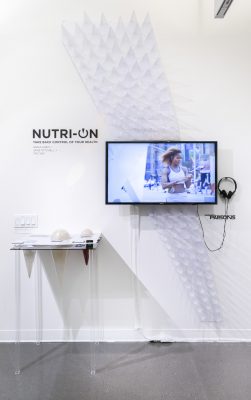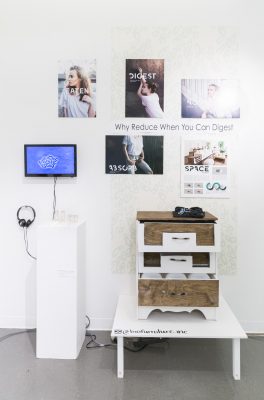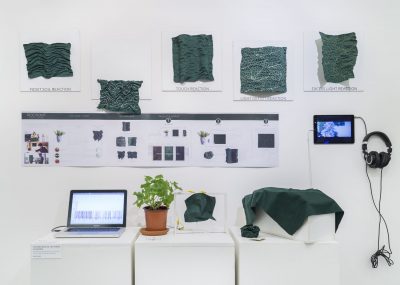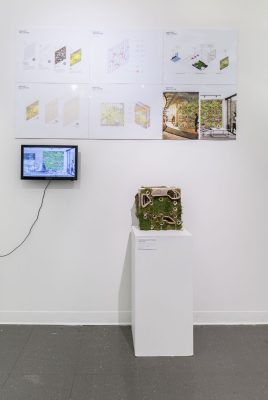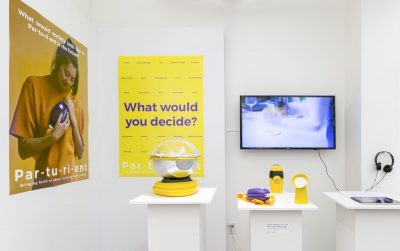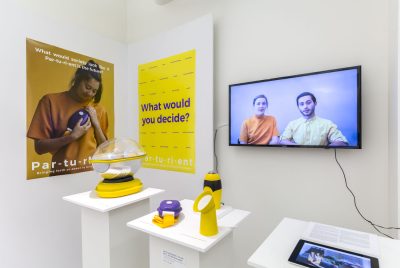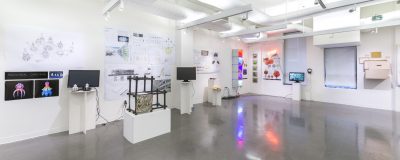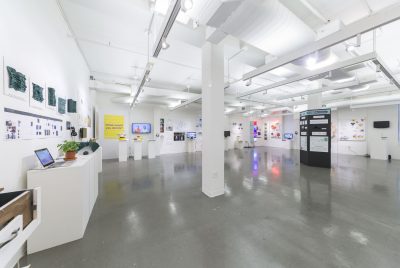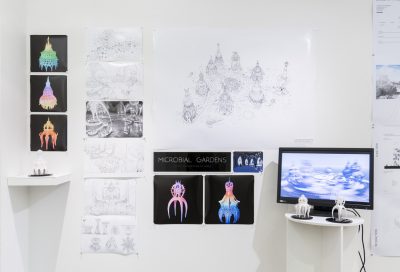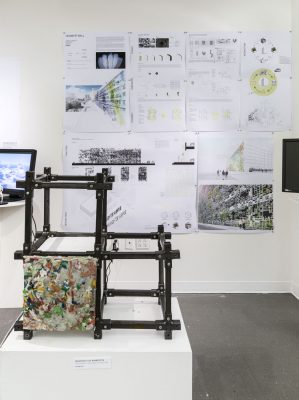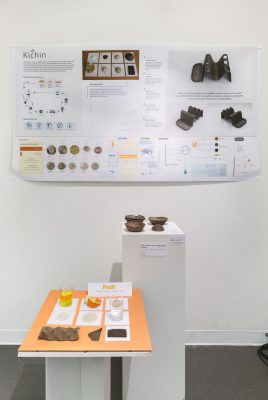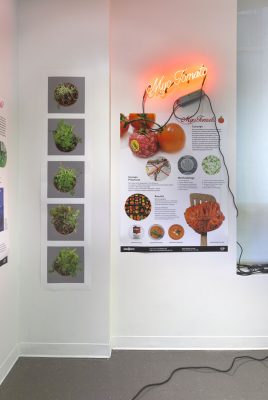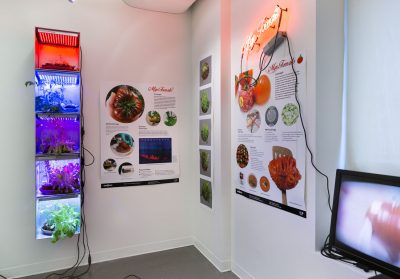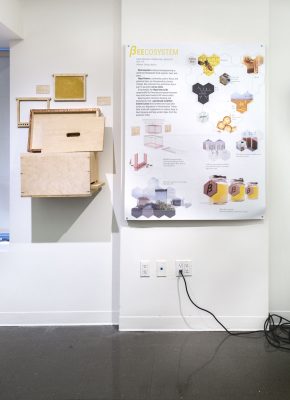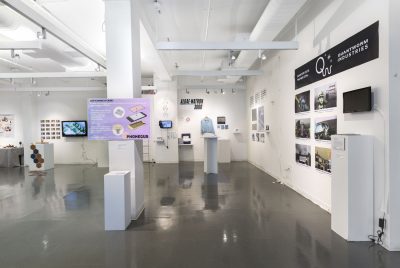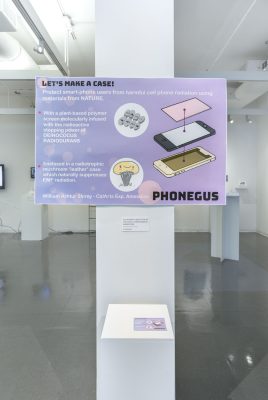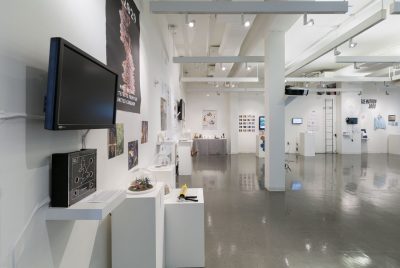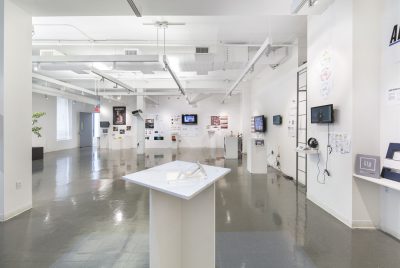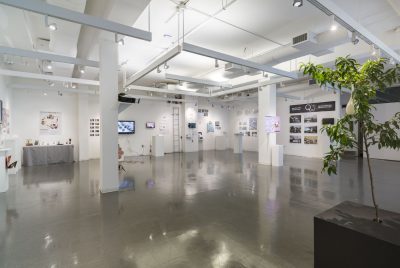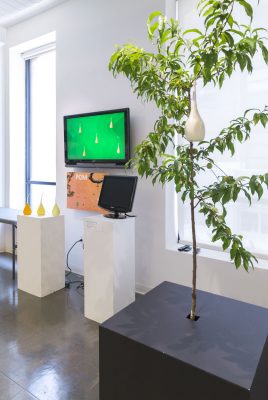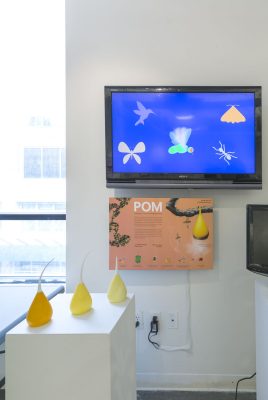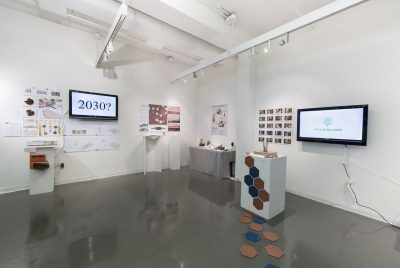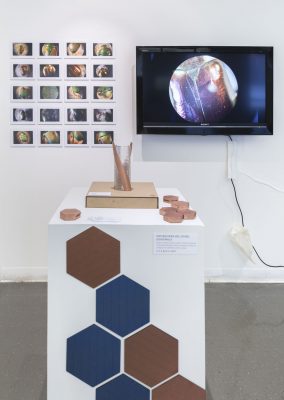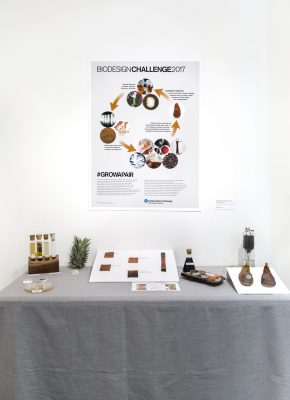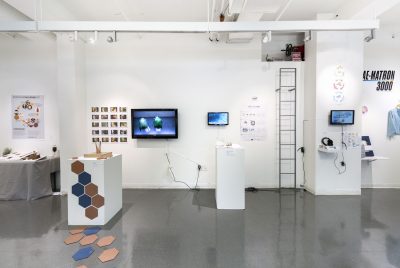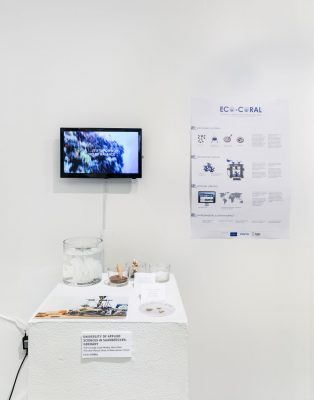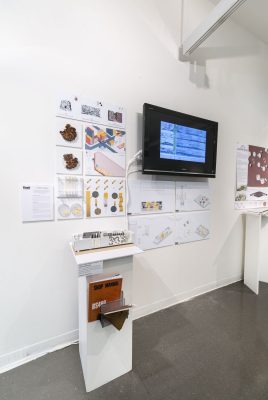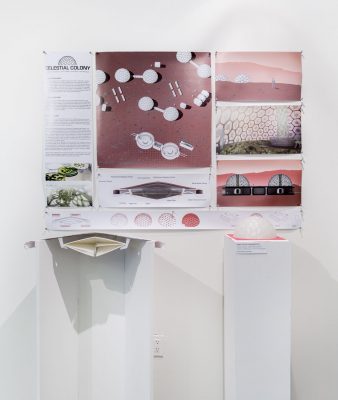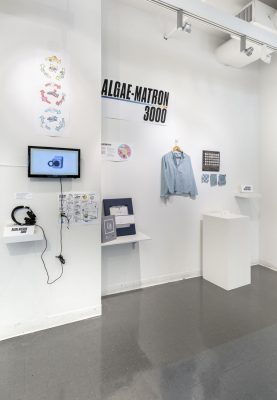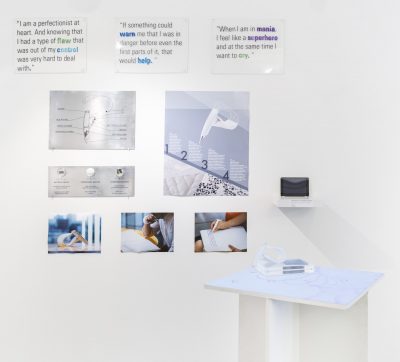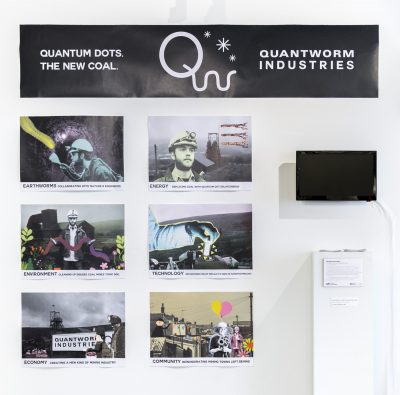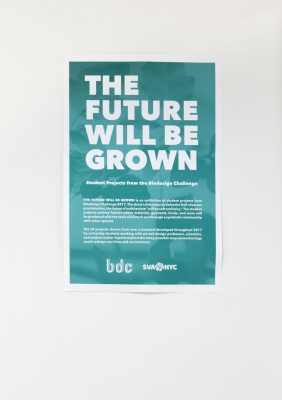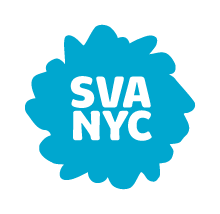PARTICIPANTS
University of Colorado Denver
Jenny Filipetti, Andrew Henderson, Stephen Lewis, & Alex S wanson
RXN BIOSENSOR
RXN Wristband glows when a user’s blood alcohol content is over the legal limit to drive. It can be grown sustainably and biomanufactured at scale. Designers utilize the wearable as a platform for building and adding biosensors for new metrics.ArtEZ
Lovisa Minkiewicz, Jeroen v an Kempen, & Jasmijn van der Weide
PAR-TU-RI-ENT
Par-tu-ri-ent imagines a future where pregnancy is one of several ways to carry a child to term. The project considers the social consequences of new reproductive technologies.
Pratt Industrial Design
Esther Chang, Jil Bereblum, Phoenix L ai, & Anna Lu
Kichin
Kichin is a strong and moldable bioplastic made from a combination of chitosan mixed with proteins and food waste. It can be used as a substitute for conventional plastics found in housewares, electronics, and packaging.
Louis Alderson-Bythell, Greg Orrom S wan, Tashia Tucker, & Sam Roots
CalArts Critical Studies
Cameron Creath, Hunter Janos, Cameron Meakin, & F awn Quinn
MICROBIAL GARDENS
Microbial Gardens is a full-sized experience of the microscopic world. Guests stroll among photosynthetic architecture where each tower is a unique microbiome generating light, color, and smells
Central Saint Martins
Olivia Bargman & Nina C utler
QUANTWORM MINE
Quantworm Industries is a nanotech wormery on former coal mining sites in South Wales that utilizes the earthworm’s natural ability to bio-remediate contaminated soil and bio-synthesize nanoparticles called quantum dots (QDs) from heavy metals.
Fashion Institute of Technology
Arianna Wong, Dylon Shepelsky , & Dani Esposito
GROWAPAIR
Growapair is a pair of mycelium shoes grown from mushroom and kombucha culture for a microbial leather upper, which is stitched with pineapple leaf fibers foraged from smoothie shop trash, husked by hand and dyed with natural pigment from avocado seeds, madder root, and cochineal beetles.
Universidad del Istmo
Paula Cecilia Escobar Juárez, Mónic a Mariela Coronado Martínez, P aulina Nathalia Medina Villegas, & Gabriela Cohen V argas
IT’S A BUG’S LIGHT
It’s a Bug’s Light imagines color changing paints based on the armor of the Coprophage Beetle. The beetle gains its metallic, red, blue, yellow, and green colors from the line patterns and parallel layered nanostructures on its surface.
CalArts Experimental Animation
William Arthur Shirey
PHONEGUS
The PhoneGus is a leather-like protective covering for smartphones that incorporates a mat of radiation-resistant Deinococcus radiodurans bacteria and radiotrophic Cryptococcus neoformans fungus. The case is meant to address consumer concerns about cell phone radiation.
Maryland Institute College of Art
Erin Kirchner, Emary P arisi, Rachel Rusk, & Sydney Sieh-Takata
ALGAE-MATRON 3000
Algae-Matron 3000 is a washing machine that dyes clothing with ephemeral pigments derived from the algae Galdieria sulphuraria. The machine is connected to a centralized water treatment system that utilizes the bioremediative properties of the organism to purify and recycle the consumed water.
Parsons School of Design
Jane Mitchell, Anna Shen, & T ao Wei
NUTRI-ON
Nutri-on is a living interface that reimagines healthcare by creating a closed-loop diagnostic and treatment system for malnutrition.
University of Pennsylvania
Angel Xiao, Ana Be atriz Valente, & K atherine L. Hayna
PERSPECT
Perspect helps individuals with Bipolar Disorder manage their symptoms when they are in danger of transitioning into manic or depressive states. It is a pen that helps users measure their mental wellbeing through electrodermal sensing and biosensing of the hand.
OCAD University
Ahlena Sultana-McGarry, Bracha Stettin, Chris A Leithe ad, & Tiff any Tremaine
SPACE MAKER
Space Maker is a social solution to fast fashion. The bio-furniture drawer set stores, consumes, and produces biofuel from used clothes and fits seamlessly in every home.
Royal College of Art
Louis Alderson-Bythell, Greg Orrom S wan, Tashia Tucker, & Sam Roots
POM (POLLINATOR & ORCHARD MANAGEMENT)
POM is an agricultural technology that encourages flies to be more efficient pollinators in scenarios of declining bee populations. It works by emitting pheromones from a device to lure groups of flies at timed intervals.
University of Minnesota
Trevor Isaacson, Claire Olson, & Susanne Flod
HHABITAT
The HHabitat is a multi-scalar facade system that filters and aggregates waste materials into a self-governing, vertical habitat, which provides both ecological and environmental solutions to issues of pollution and invasive species.
Rensselaer Polytechnic Institute
Mannion O’Connor, Vijay Nambiar, Jesse Goguen, Will Rugo, Sydney Cheng, Jerry Huang, & John Klingelhofer
MOSS-FET
Moss-Fet is a DIY educational campaign to promote the use of renewable energy. Potential modifications include water remediation systems, the scale of the system itself, and the medium used to produce electricity.
Universidad de los Andes
Paula Andrea Molina O sorio, Nicole Senz Giusti, & Daniel Shambo Rodriguez
ROOTKNIT
RootKnit is a shapeshifting surface connected to plants. Using multiple sensors, RootKnit can react to the plants’ conditions and then translate that data into surface movements and shapes. This creates a new way of communicating, understanding, and connecting to plants and the environment.
Arizona State University
Jacob Sullivan, Veronika Volkova, Ryan Wertz, & Loren Benal ly
LIFE/LIGHT
Life/Light is an integrated system that blurs the boundary between living nature and artifacts. The system provides evening light, energy, and greywater treatment for a human habitat using bioluminescent algae.
The University of Edinburgh
Eva Auer, Sean Greaves, & Joseph Rev ans
UKEW 2029
UKEW 2029 explores how the socio-political landscape of the United Kingdom could interact with advances in biotechnology. A collection of physical artifacts, photographs, and text bring to life a possible future in which biotech is ubiquitous.
Kent State University
Jonathan Rankin, Hugh Patton, Jonathan Visgaitis, Gerald Hopper, & Julien Remi Nguyen
CELESTIAL COLONY
Celestial Colony is a water filter that treats wastewater by pumping it through “algae facets” in a geodesic dome, which filters out nutrients from the water and carbon dioxide from the air. Once the algae has collected the nutrients, it can be used as fertilizer to grow plants within the dome, while the treated water can be reused as greywater or further filtered into potable water.
The University of Applied Sciences Saabrücken
Patricia Groß, Sarah Modery, Maria Masi- Mörsdorf, Manuel Oexle, & Abdurrahman Yilmaz
ECO-CORAL
A 3D printed alternative to vanishing coral reefs, Eco-Coral forms a habitat and offers nutrients for marine flora, fauna, and microorganisms by using natural materials.
Pratt Architecture
Ashley Katz, Batya Abadie, Andy Kim, K ay Choi, Annette Veliz, E laine Tan, Ann Chai, Alejandra Chinea, Alicem Bo zdag, Katherine Choate, & Martin Orr
SYMBIOTIC MERGER
An architectural wall grown by establishing a relationship between Bacillus subtilis and kombucha culture, the project is a prototype that could be integrated into spaces to change energy profiles, materials, and the resiliency of architectural structures.
New York University
Dana Abrassart, Kadallah Burrowes, Chester Dols, & Jenny Lim
BEECOSYSTEM
Beecosystem connects brewing and beekeeping with a genetically modified brewer’s yeast that synthesizes beta acids from hops as a byproduct of fermenta
tion. These beta acids supplement or replace hops in beer brewing and help protect bees from parasitic mites.
